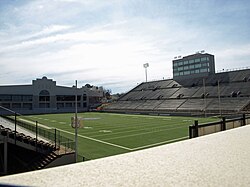Cramton Bowl

Cramton Bowl in 2012
|
|
| Location | 1022 Madison Avenue, Montgomery, Alabama 36107 |
|---|---|
| Coordinates | 32°22′46″N 86°17′35″W / 32.37949°N 86.293002°WCoordinates: 32°22′46″N 86°17′35″W / 32.37949°N 86.293002°W |
| Owner | City of Montgomery |
| Capacity | 21,000 |
| Surface | FieldTurf |
| Opened | 1922 |
| Tenants | |
|
Camellia Bowl (NCAA) (2014–) Blue–Gray Football Classic (1939–2001) Montgomery Public Schools Alabama State Hornets (SWAC) (1923–2012) Faulkner Eagles (NAIA) (2007–present) Alabama Crimson Tide (NCAA) (1922–1954) Chattanooga Lookouts (Southern League) (1943) Montgomery Rebels (Southeastern League) (1938–1949) Montgomery Bombers (Southeastern League) (1937) Montgomery Lions (Southeastern League) (1927–1930) |
|
Cramton Bowl is a 21,000-seat stadium located in Montgomery, Alabama. Cramton Bowl opened in 1922 as a baseball stadium and has been home to Major League Baseball spring training, and to minor league baseball. Today, however, its primary use is for American football.
It is the host of the annual Camellia Bowl for the NCAA Division I Football Bowl Subdivision, and of Montgomery's five high school squads. It was home to the Blue-Gray Football Classic, an all-star game usually played on Christmas Day, the Alabama State Hornets football team, and hosted the first ever football game played under the lights in the South.
Cramton Bowl is named for Fred J. Cramton, a local businessman who donated the land on which the stadium is built. After a conversation with friends about the need for a baseball stadium, Cramton donated his sanitary landfill to the city so a facility could be constructed there. The city held the land for a time and then returned it, stating that Cramton’s stadium idea was too big of a project for the city to undertake. Cramton then decided to take matters into his own hands; with the help of the Junior Chamber of Commerce, Cramton raised $33,000 to build the sports venue.
Seating capacity was expanded in 1929 to 7,991. More additions were made in 1946, increasing the seating capacity to 12,000. East stands were added in 1962 bringing the seating capacity up to 24,000. After new renovations were completed in July 2011 the capacity was reduced to 21,000.
The first baseball game played on the new field was in May 1922 between Auburn University and Vanderbilt University. Shortly after its completion in 1922 the Philadelphia Athletics decided to move their spring training operations from Eagle Pass, Texas to Montgomery, Alabama. They used the facility for their 1923 and 1924 spring training and exhibition games before moving to a newer stadium in Fort Myers, Florida.
...
Wikipedia
